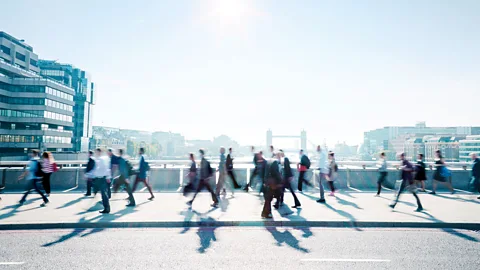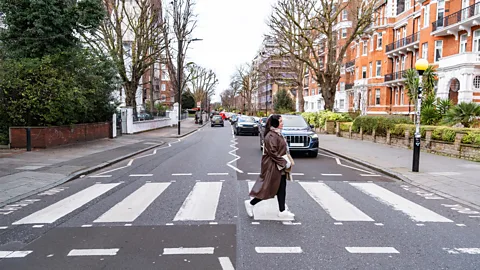The everyday activity that can reveal your brain's age
 Getty Images
Getty ImagesThe speed at which you walk can reveal profound insights into your brain's rate of ageing – with slower walkers having smaller brains and fundamental differences in crucial structures.
It might seem trivial, but how quickly you can walk from A to B can reveal a great deal about the inner workings of your body and mind. Research has shown that the speed at which you walk to the shops, the local park, or the bus stop, can predict your chance of being hospitalised, suffering a heart attack, and even dying. In fact, a person's gait speed can even be used to reveal their rate of cognitive ageing.
The walking speed test is a way of assessing someone's functional capacity – their ability to perform daily tasks around the house and maintain independence. It can also reveal how frail a person is, and predict how well they will respond to rehabilitation after a stroke.
Although it is normal for people to walk more slowly as they age, a precipitous decline in the speed of someone's gait could indicate that something more serious is going on.
"When a person's normal walking pace declines, it is often associated with underlying health declines," says Christina Dieli-Conwright, a professor of medicine at Harvard Medical School, who studies the effects of exercise on cancer prognosis.
"It might be that the person has a chronic condition which has meant that they haven't been moving as much or have become sedentary. That means that, more than likely, they've experienced a decrease in muscle strength, and t mobility, which unfortunately leads to further health declines," says Dieli-Conwright.
A simple technique
To perform the walking speed test, all you need is a stopwatch and a way of measuring distance, such as a tape measure. There are two common versions.
If you are outside and you have lots of space, you could try the 10m (33ft) walking speed test. First, measure out 5m (16.5ft), followed by another 10m. To get started, it's recommended to walk for 5m to get up to your normal speed, then walk at your normal pace for 10m. To calculate your walking speed simply divide 10m by the number of seconds it took to walk that distance.
 Getty Images
Getty ImagesIf you're at home and space is more limited, you could try the 4m (13.2ft) walking speed test. With this test, measure out 1m (3.3ft), followed by 4m. The idea is to use the first metre to get up to speed, then time how long it takes to walk for 4m at your usual pace. To work out your speed, divide four metres by the number of seconds it took you to walk that distance.
Find out how you compare
For an idea of how you compare to other people, the average walking speed of a 40-49 woman is 1.39m/s (4.6ft/s), and 1.43m/s (4.7ft/s) for a 40-49-year-old man.
If you are aged 50-59, then the average walking speed is 1.31m/s (4.3ft/s) for a woman, and 1.43m/s (4.7ft/s) for a man.
For 60-69 year-olds, average gait speed falls to 1.24m/s (4.1ft/s) for a woman, and 1.43m/s (4.7ft/s).
For 70-79 year-olds, average walking speed is 1.13m/s (3.7ft/s) for a woman, and 1.26m/s (4.16ft/s) for a man.
Finally, for 80-89 year-olds, gait speed is around 0.94m/s (3.1ft) for a woman, and 0.97m/s (3.2ft/s) for a man.
Alternatively, there are many apps you can use to measure your walking speed, including fitness trackers like Walkmeter, MapMyWalk, Strava, and Google Fit, which use GPS to track distance and time, allowing them to calculate your speed.
Studies have shown that gait speed is a significant predictor of life expectancy in older adults. For example, researchers at the University of Pittsburgh pooled together the results of nine studies which collectively tracked more than 34,000 community-dwelling adults aged 65 years or older aged between six and 21 years. The study showed that that gait speed was significantly associated with lifespan. For example, men with the slowest walking speeds at age 75 had a 19% chance of living for 10 years, compared to men with the fastest walking speeds who had an 87% chance of survival.
One explanation is that people who are already unwell tend to be less mobile. However a 2009 study in found that even amongst healthy adults aged over 65, participants with low walking speed were around three times more likely to die of cardiovascular disease during the study period compared with people who walked faster.
"Walking seems like such a simple thing – most of us don't think about it, we just do it," says Line Rasmussen, a senior researcher in the department of Psychology and Neuroscience at Duke University, North Carolina.
 Getty Images
Getty Images"But walking actually relies on many different body systems working together: your bones and muscles carry and move you, your eyes help you see where you're going, your heart and lungs circulate blood and oxygen, and your brain and nerves coordinate it all," Rasmussen adds.
According to Rasmussen, as we age, the function of these systems starts to slow down – and a slower walking speed can therefore reflect this overall decline and be a sign of advanced ageing.
This doesn't just apply to older adults. In a 2019 study, Rasmussen and colleagues found that, even amongst 45-year-olds, a person's walking speed could predict the rate at which their brain and body were ageing.
Rasmussen and researchers at Duke University took 904 people aged 45 who were part of the Dunedin Multidisciplinary Health and Development Study, a longitudinal research project which has followed the lives of over 1,000 people born between 1972 and 1973 in Dunedin, New Zealand. Individuals in the cohort have had their health and cognitive function assessed regularly over their entire lifespans.
"I was surprised by how much variation there was in walking speed among people who were all the same age," says Rasmussen. "You might expect everyone at 45 to be somewhere in the middle, but some walked as quickly as healthy 20-year-olds, while others walked as slowly as much older adults," she says.
The study revealed that 45-year-olds with slower gait speeds showed signs of "accelerated ageing", with their lungs, teeth and immune systems in poorer shape compared to those who walked faster. They also had 'biomarkers' associated with a faster rate of ageing, such as raised blood pressure, high cholesterol, and lower cardiorespiratory fitness. The found that slow walkers had other signs of physical ill health, too, such as weaker hand-grip strength and more difficulty rising from a chair. (Read more from the BBC about the test for your chances of living to 100 and the test that reveals how well you're ageing.)
Rasmussen and colleagues also found that slow walkers showed signs of advanced cognitive ageing. For example, they tended to score lower on IQ tests overall, performing worse on tests of memory, processing speed, reasoning and other cognitive functions. MRI scans also showed that this cognitive deterioration was accompanied by observable changes in the participants' brains. Slower walkers had smaller brains, a thinner neocortex – the outermost layer of the brain, which controls thinking and higher information processing – and more white matter. Intriguingly, even the faces of slow walkers were rated as ageing at a faster rate than the other participants.
More like this:
• Sit-to-stand: The simple test that reveals how you're ageing
In all, the research suggests that the bodies and brains of slow walkers age at a faster rate to those of quick walkers. There were also signs that these health differences were present from an early age, as researchers were able to predict the walking speed of 45-year-olds based on intelligence, language and motor skills tests taken when the participants were just three years old.
 Getty Images
Getty Images"What surprised me most was finding a link between how fast people walked at age 45 and their cognitive abilities all the way back in early childhood," says Rasmussen. "This suggests that walking speed is not just a sign of ageing, but also a window into lifelong brain health."
However, readers who class themselves as slow walkers needn't be too disheartened, as there are many things we can do to improve our walking speed. As part of her research to help cancer patients, Dieli-Conwright produces exercise regimes to help people recovering from chemotherapy regain their strength. Participants are advised to increase the duration and intensity of their walking exercise every three to four weeks to improve their fitness. And there are even simpler things that people can do.
"Take any opportunity you can to walk more regularly, as remaining physically active is so important," says Dieli-Conwright. Her tips include parking further away from your destination, meeting up with friends to walk socially, or taking a pet to the local park.
"It's important to take walking breaks, especially for individuals who have a more sedentary job," says Dieli-Conwright. "Even if it's just a five-minute walking break to go to the bathroom, or a five-minute quick walk around the block – it's vital to interrupt that sitting time."
--
For trusted insights into better health and wellbeing rooted in science, sign up to the window._taboola = window._taboola || []; _taboola.push({ mode: 'alternating-thumbnails-a', container: 'taboola-below-article', placement: 'Below Article', target_type: 'mix' });
